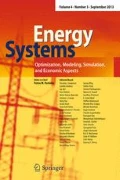The development of models and solution techniques for planning the operation and expansion of power distribution systems (PDS) is of great importance for power utilities. The minimization of the overall costs can be a considerable challenge given the size of these systems. For instance, thousands of feasible design options can arise from a feeder design definition in a system with a single substation and finding the overall least-cost plan or topology for a PDS can be a very difficult task. Furthermore, in the recent years PDS from the substations to the customers are facing significant changes, due to the growing number of distributed and variable energy generation resources and the smart grid implementation. The abilities to dynamically optimize the operation, integrate diverse distributed generation types, and integrate demand response and energy-efficiency resources are needed in this modern power system era. Engineer’s understanding of the system and its costs, performance, and tradeoffs can be facilitated with optimization concepts.
The applications of optimization in PDS are many, as one can see in the papers that are part of this special issue. This special issue covers various aspects of optimization applied in electrical power systems, ranging from theoretical contributions to practical applications. The guest editors are grateful to the contributing authors and to the many referees for their thorough and constructive reviews. The resulting contributions are as follows.
-
1.
In “Optimal location strategy for distributed generation to maximize system voltage stability based on line sensitivity factors”, Kou, Jung, and Park present a method to determine the optimal location of photovoltaic distributed generation units to improve the voltage stability level.
-
2.
In “Optimal siting and sizing of renewable energy sources, storage devices, and reactive support devices to obtain a sustainable electrical distribution system”, Dominguez, Kasmaei, Lavorato, and Mantovani present a framework to optimally place renewable-based distributed generation, energy storage systems, and capacitor banks in PDS.
-
3.
In “A stochastic mixed-integer conic programming model for distribution system expansion planning considering wind generation”, Ortiz, Kasmaei, Lopez, and Mantovani present a stochastic scenario-based approach for the distribution system expansion planning problem.
-
4.
In “A UKF-based approach to estimate parameters of a three-phase synchronous generator model”, Geraldi Jr., Fernandes, and Ramos present a method to estimate the parameters of a three-phase synchronous generator model based on the Unscented Kalman Filter.
-
5.
In “A method for evaluating building retrofit effects on a decentral energy system by a sector coupling operation and expansion model”, Hussein proposes a methodology to quantify the system effects of building retrofit on a decentralized energy system.
-
6.
In “An accelerating Benders’ decomposition approach to the integrated supply chain network design with distributed generation”, Khodayifar, Raayatpanah, and Pardalos present a method considering distributed generation for the integrated supply chain networks and obtain the optimal locations, sizing, and the service areas of distributed generation.
-
7.
In “Optimization techniques applied to planning of electric power distribution systems: a bibliographic survey”, Resener, Haffner, Pereira, and Pardalos present a comprehensive survey of the models and methods used to solve planning problems of PDS expansion.
-
8.
In “Enhancing operation of decentralized energy systems by a regional economic optimization model DISTRICT”, Thomsen presents a regional energy system model, which targets the minimization of the operation cost of a system with the possibility of trading electricity at a spot and reserve market outside of system borders.
-
9.
In “Hybrid genetic dragonfly algorithm based optimal power flow for computing LMP at DG buses for reliability improvement”, Veeramsetty, Venkaiah, and Kumar present a hybrid method to compute local marginal price at distributed generation buses with the objective of improving reliability in PDS.
-
10.
In “The impact of electricity tariffs on residential demand side flexibility: Results of bottom-up load profile modeling”, Hayn, Zander, Fichtner, Nickel, and Bertsch present a bottom-up model that simulates and optimizes residential load profiles in the presence of different tariffs.
-
11.
In “A mixed-integer formulation of OLTC dynamics to minimize distribution and subtransmission tap changes induced by wind and solar power variations”, Baghsorkhi proposes a centrally coordinated voltage control scheme, considering variation of wind and solar generation, with the objective of reducing tap-change operations and resistive losses in sub-transmission and distribution networks.
-
12.
In “Coordinated control of active distribution networks to help a transmission system in emergency situation”, Morin, Colas, Dieulot, Grenard, and Guillaud present coordination strategies regarding reactive power control in medium voltage networks to support high voltage networks.
Author information
Authors and Affiliations
Corresponding author
Rights and permissions
About this article
Cite this article
Resener, M., Pardalos, P.M. & Haffner, S. Special issue on “Optimization in electric power distribution systems”. Energy Syst 9, 469–471 (2018). https://doi.org/10.1007/s12667-018-0290-z
Received:
Accepted:
Published:
Issue Date:
DOI: https://doi.org/10.1007/s12667-018-0290-z

